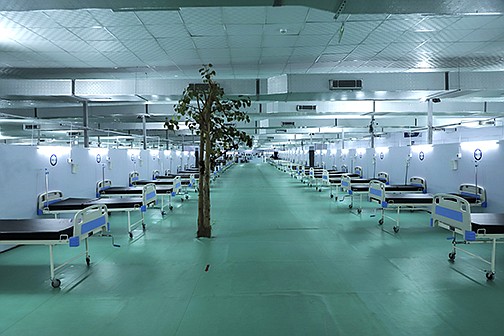NEW DELHI -- A potentially worrisome variant of the coronavirus detected in India may spread more easily. But the country is behind in doing the kind of testing needed to track it and understand it better.
On Monday, the World Health Organization designated the new version of the virus a "variant of concern" based on preliminary research, alongside those that were first detected in Britain, South Africa and Brazil but have spread to other countries.
"We need much more information about this virus variant," said Maria Van Kerkhove, WHO's technical lead for covid-19. "We need more sequencing, targeted sequencing to be done and to be shared in India and elsewhere so that we know how much of this virus is circulating."
Viruses mutate constantly, and the surge in infections in India has resulted in more opportunities for new versions to emerge.
But India was slow to start the genetic monitoring needed to see if those changes were happening and if they were making the coronavirus more infectious or deadly.
Such variants also need to be monitored to see if mutations help the virus escape the immune system, potentially leading to reinfections or making vaccines less effective. For now, the WHO stressed that covid-19 vaccines are effective at preventing disease and death in people infected with the variant.
[CORONAVIRUS: Click here for our complete coverage » arkansasonline.com/coronavirus]
The WHO on Tuesday urged more studies on the variant first detected in India in a report that said the strain has been detected in 44 countries so far.
Indian scientists say their work has been hindered by bureaucratic obstacles and the government's reluctance to share vital data. India is sequencing around 1% of its total cases, and not all of the results are uploaded to the global database of coronavirus genomes.
When there isn't enough sequencing, there will be blind spots and more worrisome mutations could go undetected until they're widespread, said Alina Chan, a postdoctoral researcher at Broad Institute of MIT and Harvard who is tracking global sequencing efforts.
Ravindra Gupta, a professor of clinical microbiology at the University of Cambridge, said: "It has all the hallmarks of the virus that we should be worried about."
First detected in the coastal Maharashtra state last year, the new variant has now been found in samples in 19 of the 27 states surveyed. Meanwhile a variant first detected in Britain has declined in India in the past 45 days.
Indian health officials have cautioned that it is too soon to attribute the nation's surge solely to such variants. Experts point out that the spread was catalyzed by government decisions to not pause religious gatherings and crowded election rallies.
Meanwhile, coronavirus cases are rising in Asia and the Pacific with over 5.9 million new confirmed infections in the past two weeks, more than in all other regions combined, the International Federation of the Red Cross said Wednesday.
It warned that the surge is pushing hospitals and health systems to the brink of collapse.
Seven out of 10 countries globally that are doubling their infection numbers the fastest are in Asia and the Pacific, it said. Laos took just 12 days to see its cases double, and the number of confirmed infections in India has doubled in under two months to more than 23 million, the Red Cross said in a statement.
It said Oxford University's Our World in Data reported more than 5.9 million new covid-19 infections in Asia and the Pacific during the two weeks. Official figures for much of the region are widely believed to be undercounts.
While vaccination campaigns are underway in the region, the Red Cross said they are hampered by shortages, hesitancy and the costly logistics of reaching many areas across the region.
Additionally, Sinovac Biotech's vaccine has proved effective in a real-world study in Indonesia, an encouraging sign for the dozens of developing countries reliant on the Chinese shot.
Indonesia tracked 128,290 health workers in capital city Jakarta from January to March and found that the vaccine protected 98% of them from death and 96% from hospitalization as soon as seven days after the second dose, Pandji Dhewantara, a Health Ministry official who oversaw the study, said in a Wednesday news conference.
Information for this article was contributed by Danica Kirka, Chonchui Ngashangva and staff members of The Associated Press; and by Bhuma Shrivastava and staff members of Bloomberg News (WPNS).







